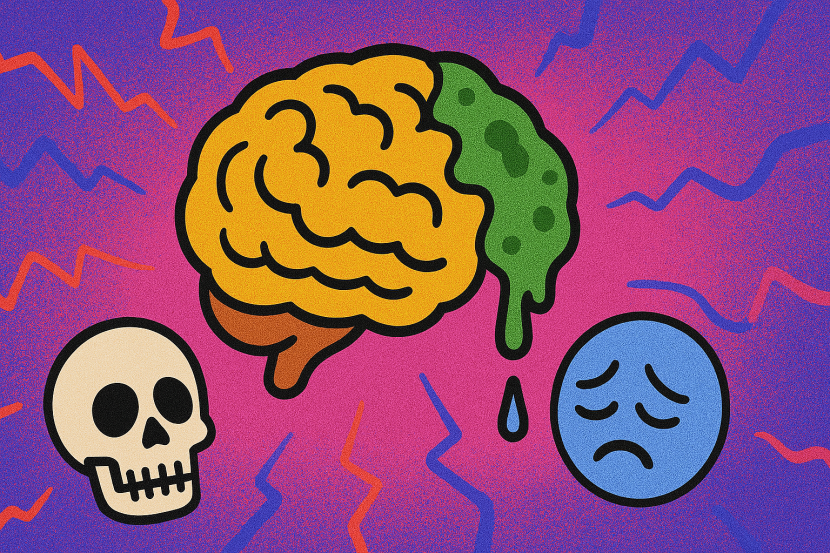If you’ve ever found yourself watching a TikTok with Subway Surfers gameplay in the corner, a robotic voice telling a story about a haunted McDonald’s, and random sound effects blaring in the background — congratulations, you’ve experienced the brain rot aesthetic. It’s chaotic, overstimulating, and makes absolutely no logical sense — and that’s exactly why Gen Z loves it. What started as a joking term to describe digital burnout or meme overload has evolved into a full-blown cultural vibe: fast, unfiltered, and unapologetically absurd. But behind the fried visuals and noise lies something deeper — a reflection of how an entire generation is processing (and parodying) the chaos of the world around them.
The Anatomy of Brain Rot Content
So, what exactly is brain rot content made of? Imagine someone tossed pop culture references, low-res memes, AI voices, video game clips, and a complete disregard for narrative structure into a blender — then hit max speed. That’s the brain rot aesthetic in its rawest form.
This genre thrives on sensory overload. You’ll often see:
- Subway Surfers or Minecraft parkour clips playing beneath dramatic storytimes.
- Synthesized voices (often British or robotic) narrating chaotic tales.
- Random sound effects, zoom-ins, emoji spam, and glitchy text overlays.
- Jumps between topics so fast your brain barely has time to catch up.
There’s little to no context. The humor is often deeply ironic, self-referential, and intentionally unpolished. It’s the digital equivalent of inside jokes with the internet — but instead of making sense, it leans into the nonsense.
But it works. The messiness is part of the charm. The aesthetic mirrors the fragmented, fast-paced way Gen Z consumes information, learns trends, and processes emotions. It’s content designed for short attention spans, yes — but also for high-speed pattern recognition and meme fluency.
Why Gen Z Finds Comfort in the Chaos
For Gen Z, brain rot content isn’t just noise — it’s relatable chaos. In a world filled with stress, uncertainty, and digital overload, absurd and overstimulating content becomes a way to cope, laugh, and process it all. Raised on fast-paced internet culture, Gen Z naturally connects with irony, randomness, and layered humor. The chaos mirrors their reality, making it strangely comforting — like choosing your own kind of overload in a world that already feels overwhelming.
Psychological Angle: Overstimulation or Catharsis?
So, is brain rot content melting our minds or saving our sanity? Psychologically, the answer is… a little bit of both.
On one hand, constant overstimulation—rapid cuts, loud noises, fast scrolling—can wear down attention spans and increase mental fatigue. Our brains weren’t built to juggle five sensory inputs at once while decoding irony layered under a meme inside a TikTok.
But here’s the twist: for many, this chaos offers catharsis. It becomes a release valve, a digital scream into the void. Consuming absurd, contextless content helps people emotionally detach from real-life stressors, if only for a moment. It’s a kind of “mental noise-canceling,” ironically achieved through even louder noise.
There’s also the dopamine factor — short-form, high-stimulus content triggers instant rewards. It feels good, even if it’s not good for you in the long run.
In essence, brain rot lives on the edge between overstimulation and emotional relief. It may not be traditional self-care, but in a chaotic world, it’s a uniquely modern form of psychological survival.
Examples of Peak Brain Rot Aesthetic
Trying to explain brain rot aesthetic is one thing — but seeing it? That’s where the madness truly shines. Here are some of the most iconic examples that define the genre:
- Subway Surfers gameplay + Reddit horror story + robotic voiceover — the holy trinity of TikTok overstimulation.
- A capybara wearing sunglasses floating across the screen while the “GTA San Andreas” theme plays in reverse. No context. No explanation. Just vibes.
- Deep-fried SpongeBob memes from 2008 that have been reposted so many times, they’ve lost all resolution—and somehow gained meaning.
- Sigma male edits of goofy characters, like Mr. Bean with Andrew Tate quotes, underscored by epic music.
- AI-generated images of Shrek in a courtroom or Obama playing Minecraft — accompanied by a voiceover explaining “lore” that never happened.
These examples aren’t just weird for the sake of weird. They’re a digital collage of nostalgia, irony, and sensory chaos — a reflection of how Gen Z experiences, processes, and even mocks the world around them.
Criticism vs. Celebration
Like any cultural movement, the brain rot aesthetic has its critics — and its defenders.
Critics argue it’s a sign of declining attention spans, intellectual laziness, and overstimulation addiction. They see it as content that’s meaningless, shallow, and devoid of creativity — a fast-food diet for the mind. To them, it’s not art; it’s digital junk food.
But on the flip side, Gen Z and defenders of the aesthetic see something deeper. Brain rot content is often satire in disguise — a way to mock societal norms, internet culture, and even itself. It flips the script on “high effort” content by celebrating randomness, absurdity, and humor that’s entirely internet-native.
Where older generations might see chaos, Gen Z sees relatability, resilience, and raw creativity. It’s not about being lazy — it’s about finding meaning (or at least laughter) in the mess.
At its core, the brain rot aesthetic is both a commentary on modern media and a creative rebellion against traditional standards of “good” content.
Author’s View
As someone who’s spent more time than I’d like to admit doom-scrolling through TikTok rabbit holes and watching Subway Surfers clips narrate someone’s breakup story — I get the brain rot aesthetic. It’s weird, it’s loud, and it’s a total mess. But it also makes sense in a world that often doesn’t.
To me, brain rot isn’t a sign of degeneration — it’s a reflection of adaptation. Gen Z isn’t broken or numb; they’re just fluent in a different language — one of irony, speed, chaos, and layered meaning. And in that digital chaos, they’ve found a sense of connection, humor, and even comfort.
Sure, not every piece of brain rot content is deep or thought-provoking. But maybe it’s not supposed to be. Maybe it’s okay for content to just be absurd, hilarious, and borderline unhinged — especially when the world feels the same way.
In the end, I don’t see brain rot as the end of culture. I see it as the evolution of it.




